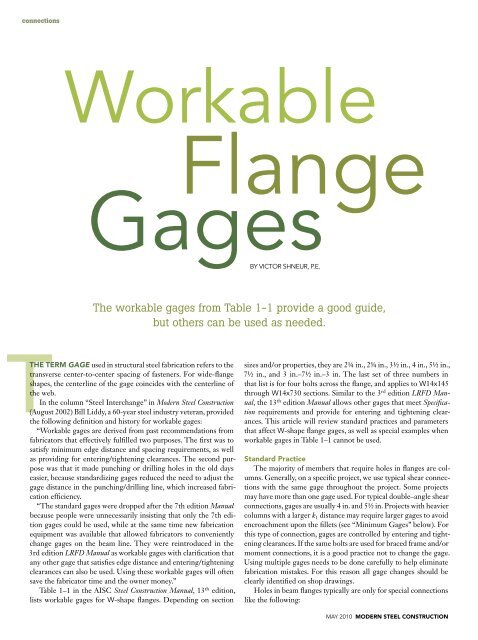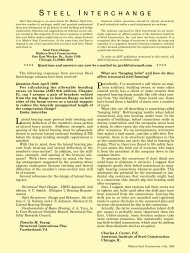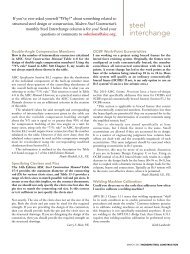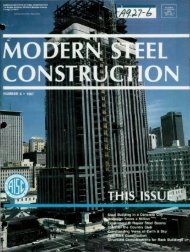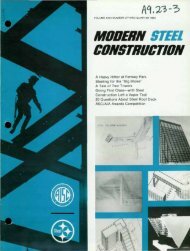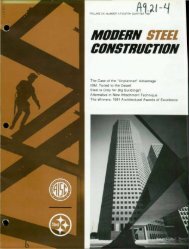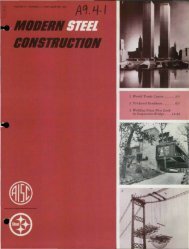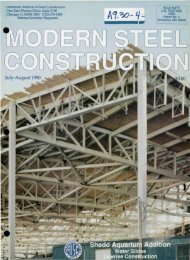Workable Flange Gages - Modern Steel Construction
Workable Flange Gages - Modern Steel Construction
Workable Flange Gages - Modern Steel Construction
Create successful ePaper yourself
Turn your PDF publications into a flip-book with our unique Google optimized e-Paper software.
connections<br />
<strong>Workable</strong><br />
<strong>Flange</strong><br />
<strong>Gages</strong><br />
By Victor Shneur, P.e.<br />
The workable gages from Table 1-1 provide a good guide,<br />
but others can be used as needed.<br />
ThE TERM gage used in structural steel fabrication refers to the<br />
transverse center-to-center spacing of fasteners. For wide-flange<br />
shapes, the centerline of the gage coincides with the centerline of<br />
the web.<br />
In the column “<strong>Steel</strong> Interchange” in <strong>Modern</strong> <strong>Steel</strong> <strong>Construction</strong><br />
(August 2002) Bill Liddy, a 60-year steel industry veteran, provided<br />
the following definition and history for workable gages:<br />
“<strong>Workable</strong> gages are derived from past recommendations from<br />
fabricators that effectively fulfilled two purposes. The first was to<br />
satisfy minimum edge distance and spacing requirements, as well<br />
as providing for entering/tightening clearances. The second purpose<br />
was that it made punching or drilling holes in the old days<br />
easier, because standardizing gages reduced the need to adjust the<br />
gage distance in the punching/drilling line, which increased fabrication<br />
efficiency.<br />
“The standard gages were dropped after the 7th edition Manual<br />
because people were unnecessarily insisting that only the 7th edition<br />
gages could be used, while at the same time new fabrication<br />
equipment was available that allowed fabricators to conveniently<br />
change gages on the beam line. They were reintroduced in the<br />
3rd edition LRFD Manual as workable gages with clarification that<br />
any other gage that satisfies edge distance and entering/tightening<br />
clearances can also be used. Using these workable gages will often<br />
save the fabricator time and the owner money.”<br />
Table 1–1 in the AISC <strong>Steel</strong> <strong>Construction</strong> Manual, 13 th edition,<br />
lists workable gages for W-shape flanges. Depending on section<br />
sizes and/or properties, they are 21/4 in., 23/4 in., 31/2 in., 4 in., 51/2 in.,<br />
71/2 in., and 3 in.–71/2 in.–3 in. The last set of three numbers in<br />
that list is for four bolts across the flange, and applies to W14x145<br />
through W14x730 sections. Similar to the 3 rd edition LRFD Manual,<br />
the 13 th edition Manual allows other gages that meet Specification<br />
requirements and provide for entering and tightening clearances.<br />
This article will review standard practices and parameters<br />
that affect W-shape flange gages, as well as special examples when<br />
workable gages in Table 1–1 cannot be used.<br />
Standard Practice<br />
The majority of members that require holes in flanges are columns.<br />
Generally, on a specific project, we use typical shear connections<br />
with the same gage throughout the project. Some projects<br />
may have more than one gage used. For typical double–angle shear<br />
connections, gages are usually 4 in. and 51/2 in. Projects with heavier<br />
columns with a larger k 1 distance may require larger gages to avoid<br />
encroachment upon the fillets (see “Minimum <strong>Gages</strong>” below). For<br />
this type of connection, gages are controlled by entering and tightening<br />
clearances. If the same bolts are used for braced frame and/or<br />
moment connections, it is a good practice not to change the gage.<br />
Using multiple gages needs to be done carefully to help eliminate<br />
fabrication mistakes. For this reason all gage changes should be<br />
clearly identified on shop drawings.<br />
Holes in beam flanges typically are only for special connections<br />
like the following:<br />
may 2010 MODERN STEEL CONSTRUCTION
1. Column base/cap plate connections<br />
2. Bolted joist connections when the joist span is equal to or<br />
exceeds 40 ft (holes in the top flange only)<br />
3. Bolted flange-plated moment connections<br />
4. Hanger connections<br />
5. Seated connections.<br />
Using the workable gages from Table 1–1 is always suggested<br />
to help standardize details and simplify coordination, for example<br />
between the joist supplier and the steel fabricator. However, there<br />
may be cases when other gages are needed for more efficient connections.<br />
For example:<br />
1. Four bolts across the flange (of course, when the flange is<br />
wide enough) in a bolted flange-plated moment connection<br />
makes the connection more compact;<br />
2. Smaller gages may be required for hanger connections to<br />
eliminate reinforcement for flange bending.<br />
Bolted truss connections are a unique connection category.<br />
Although actual gages are determined by a number of different<br />
parameters including loads, member sizes and connection geometry,<br />
the workable gages in Table 1–1 still should be used as a guide. For<br />
example, consider a W14x132 bottom chord splice requiring two<br />
1-in.-diameter, A490–Slip Critical–OVS bolts across each flange,<br />
with inside flange splice plates (see Figure 1). In this case a gage larger<br />
than 51/2 in. should be used to provide adequate width of inside splice<br />
plates. A 9-in. gage allows using 51/2-in.-wide splice plates without<br />
fillet encroachment. As with all other connections, though, it is a<br />
good idea to change the gages as infrequently as possible.<br />
Minimum <strong>Gages</strong><br />
There are cases when it is beneficial to use gages smaller than<br />
the workable gage, like hanger connections and standard doubleangle<br />
connections to large W-column flanges. For these types of<br />
connections minimum gages need to be carefully reviewed.<br />
Minimum gages are controlled by:<br />
1. W-shape k 1 distances<br />
2. Bolt sizes<br />
3. Bolt entering and tightening clearances<br />
4. Typical gages used for connections.<br />
The W-shape k 1 distance and the bolt size need to be checked<br />
first to determine the minimum gage for any connection.<br />
Example:<br />
Column: W14×283 (k 1 = 1d in.)<br />
Bolts: 1 in. diameter, F1852<br />
Per ASTM F1852, Fig. 1, bolt head bearing surface diameter D<br />
= 1.771 in. (call it 13/4 in.).<br />
Note: Typically, tension-control bolts are oriented with nuts<br />
outside of the column to make pretensioning easier, and to<br />
allow the erector to use standard equipment.<br />
Victor Shneur, P.E., is the chief engineer<br />
for LeJeune <strong>Steel</strong> Co., Minneapolis,<br />
Minn. He is a member of the AISC<br />
Committee on Manuals and the RCSC<br />
Specifications Committee.<br />
MODERN STEEL CONSTRUCTION may 2010<br />
W14x132<br />
(k1=1<br />
9<br />
16 in.)<br />
Gage = 9 in.<br />
Figure 1: For this chord splice use of a gage larger than<br />
the suggested workable gauge allows the splice plates<br />
to be adequately sized.<br />
Check these bolts for<br />
clearance (if required,<br />
increase the gage)<br />
W - beam<br />
W14x90<br />
Figure 2: Skewed connections may reduce clearances<br />
required for bolt installation, requiring some suitable<br />
modification.<br />
Minimum column gage without encroachment =<br />
2 x (1 7 ⁄8 in.) + (13/4 in.)/2) = 51/2 in.<br />
Gage = 5 1 2 in.<br />
Bolt entering and tightening clearances should always be considered<br />
during connection design and detailing. Ignoring this will<br />
almost certainly lead to fabrication and erection problems when<br />
bolts can’t be installed or pretensioned in the shop or in the field.<br />
Figure 2 illustrates a skewed W-shape beam-to-column shear endplate<br />
connection, which should be checked for installation clearance.<br />
Using hex head bolts in lieu of tension-control bolts might<br />
be a solution when clearances are tight. Hex head bolts are shorter
than tension-control bolts and can be tightened/pretensioned by<br />
turning either the nut or the bolt head.<br />
The AISC Manual, 13 th edition provides important information<br />
for checking entering and tightening clearances for bolts:<br />
1. For conventional A325 and A490 hex head bolts: Table<br />
7–16<br />
2. For tension control F1852 and F2280 bolts: Table 7–17<br />
3. For all bolted and bolted/welded skewed connections:<br />
Table 10–13.<br />
In some cases it may be beneficial to use smaller gages to, for<br />
example, specify thinner angles or end plates that resist axial loads.<br />
However, the engineer should keep in mind that changing the gage<br />
along the column (or any other member for that matter) risks fabrication<br />
mistakes. It might be better to use thicker connection material<br />
than to find out that 40 bolt holes don’t match in the field.<br />
Maximum <strong>Gages</strong><br />
Maximum gages are normally required when:<br />
1. The flange is narrow (for example, W10x19, which has a 4-in.<br />
flange width);<br />
2. Four bolts are placed across the flange (like in truss connections);<br />
3. Using skewed beam-to-column framing (see Figure 3 for<br />
example).<br />
Maximum gages are limited by minimum edge distances<br />
required by AISC Specification Section J3.4. In determining minimum<br />
edge distance, Section J3.4 refers to Tables J3.4/J3.4M and<br />
J3.5/J3.5M if other than standard holes are used, and Section J3.10<br />
as required for checking bearing strength at the bolt holes. The<br />
Commentary for Section J3.4 states: “The minimum edge distances<br />
given in Table J3.4 and Table J3.4M are to facilitate construction<br />
and do not necessarily satisfy the bearing and tearout strength<br />
requirements in Section J3.10. Lesser values are permitted if the<br />
requirements of Section J3.10 are satisfied.”<br />
Special Cases<br />
There are connections when workable gages listed in Table 1–1<br />
simply can’t be used. In other cases, the workable gage is one possible<br />
solution but not the only solution. The following scenarios<br />
show some examples of this.<br />
Scenario #1: workable gage is inappropriate.<br />
Gravity column splices. <strong>Gages</strong> listed for bolted column splices<br />
in Table 14–3 in the AISC Manual don’t match workable gages in<br />
Table 1–1. For example, for a W14x132 column splice an 111/2 in.<br />
gage needs to be used.<br />
Figure 3, right: Skewed beam-to-column framing<br />
may require the use of maximum gages, which are<br />
limited by minimum edge distance requirements.<br />
W12x19<br />
1<br />
2 "<br />
3"<br />
Scenario #2: workable gage has an acceptable alternative.<br />
W-shape framing into a W12x35 column flange (b f = 61/2 in.)<br />
with a standard double-angle connection with 3/4-in. diameter<br />
A325–N bolts and a 4-in. gage. Even though Table 1–1 lists<br />
a 31/2-in. workable gage, a 4-in. gage also would be acceptable<br />
because providing 11/4-in. edge distance exceeds 1-in. minimum<br />
edge distance at rolled edges of shapes per Specification Section<br />
J3.4.<br />
Scenario #3: other requirements prohibit using workable gage.<br />
W16x31 cantilever (b f = 51/2 in.) connected to W14x550 (k 1 =<br />
2 3 ⁄8 in.) column flange with an extended end-plate moment connection.<br />
The bolts used are 7 ⁄8-in. diameter A325–N (D = 1.535 in.).<br />
The minimum gage for the W14x550 column is 61/4 in., however<br />
per the requirements for extended end-plate moment connections,<br />
the maximum gage should be equal to the flange width of<br />
the framing W-shape (51/2 in.) Specify a 51/2-in. gage for this connection<br />
with a shop note for the column: “Shop note: verify 7 ⁄8-in.<br />
diameter F1852 bolts can be installed at Gage = 51/2 in.” From a<br />
practical perspective, the bolts in this case are likely to encroach<br />
upon the fillet on one or both sides of the web. That encroachment<br />
is acceptable up to the limits shown in Figure 10-3 of the<br />
Manual. For larger encroachment, we also include in the shop note,<br />
“If required, grind column fillets at bolt locations.”<br />
Conclusion<br />
In most cases, deciding on the correct gage is a straightforward<br />
procedure, and the answer may change from project to project.<br />
However, in all cases during connection design, the most efficient<br />
solution should be based on these considerations:<br />
1. AISC Specification<br />
2. Special connection requirements<br />
3. Loads<br />
4. Actual framing<br />
5. Clearances<br />
6. Connection economy<br />
7. Standard practice.<br />
And that is what makes connection design interesting!<br />
1 1 2 " 1 1 4 "<br />
W14x90<br />
Bent plate shop welded to<br />
W12x19 beam and eld bolted<br />
3<br />
to column with 4 "Ø F1852-N<br />
bolts<br />
may 2010 MODERN STEEL CONSTRUCTION


